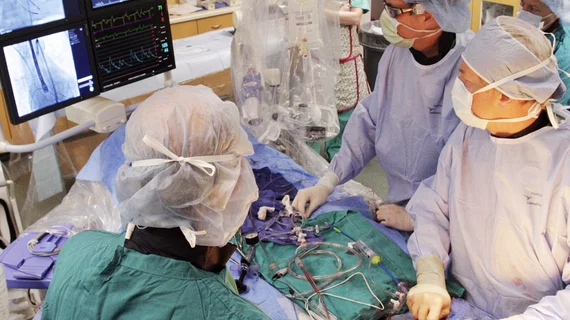TAVR vs. surgery: A new look at 1-year outcomes among moderate-risk patients with severe, symptomatic AS
Transcatheter aortic valve replacement (TAVR) is noninferior to surgical aortic valve replacement (SAVR) when it comes to all-cause mortality after one year among moderate-risk patients with severe, symptomatic aortic stenosis (AS), according to a new analysis published in JAMA.[1] A close comparison revealed that each treatment option is associated with certain benefits over the other.
The study focused on data from more than 900 patients with a median age of 81 years old who underwent either TAVR or SAVR from April 2014 to April 2018. All patients were 70 years old or older and presented with severe, symptomatic AS and a moderately increased operative risk. All procedures were performed at National Health Service (NHS) hospitals in the U.K.
While 458 patients were randomly chosen to undergo TAVR, the remaining 455 patients underwent SAVR. Five patients from the TAVR group were later moved to the surgery group after clinicians examined their case closer and three other patients did not receive treatment. Also, among SAVR patients, 17 were moved to the TAVR group and another 19 did not receive treatment.
Overall, all-cause mortality after one year was 4.6% for the TAVR group and 6.6% for the SAVR group. Hospitalizations were significantly shorter after TAVR, as one might expect, and TAVR was associated with fewer bleeding events after that initial year. Vascular complications, however, were much more common among TAVR patients (10.3%) than SAVR patients (2.4%). Mild and moderate aortic regurgitation were also more common among patients who underwent TAVR.
There was “no significant difference” after one year for 24 of the 30 secondary outcomes included in the team’s research.
“In contrast to previous trials, this trial was pragmatic, publicly funded, and designed to compare a TAVR strategy using any valve type and access route versus a conventional surgical strategy in a broad range of patients,” wrote corresponding author William D. Toff, MD, of the department of cardiovascular sciences at the University of Leicester in England, and colleagues with the UK TAVI Trial. “Inclusion was based on clinical equipoise regarding the treatment options and not bound by prespecified risk scores. Entry to the trial thus reflected a site-specific assessment of risk, encompassing factors not reflected in the risk scores such as frailty. This approach also allowed for the temporal evolution of clinicians’ individual perspectives on the risk threshold for considering TAVR as an alternative to surgery, with increasing local and global experience of the procedure as recruitment progressed.”
Related TAVR Content:
TAVR safe and effective for patients with mixed aortic valve disease
CT-FFR before TAVR improves detection of coronary artery disease, limits invasive imaging exams
Late balloon valvuloplasty safe and effective for patients with THV dysfunction
Transcaval TAVR outperforms transaxillary TAVR when femoral access is not an option
Reference:

